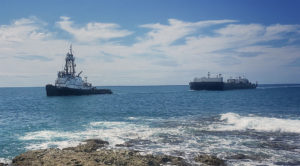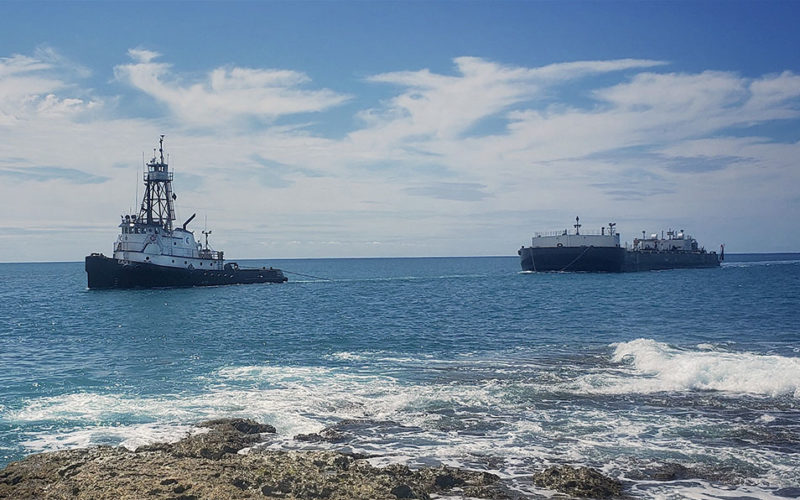
Centerline Logistics and Saltchuk have agreed to swap California assets in a move both companies expect will build on their core strengths.
Under the deal announced late last year, Centerline will sell eight tugboats in its Millennium and Starlight brands to Saltchuk. Saltchuk, meanwhile, will sell Centerline six double-hulled bunkering barges. Both companies will inherit existing contracts for these businesses, and in some cases crews will move over to the new operator.
Matt Godden, Centerline’s chief executive, said the deal fits within the company’s ongoing efforts to refocus on bunkering and terminal transports.
“We are good at petroleum transportation, particularly in the bunkering space. We have tried to reduce any distractions to that,” Godden told Professional Mariner. “For us, it is divesting from a challenging business and growing what we are good at.”
The deal expands Saltchuk’s ship-assist capabilities in the California market, where its subsidiaries AmNav and Foss Maritime already have a strong presence. Saltchuk plans to consolidate the Centerline tugs under the Starlight brand, which will operate independently and continue to manage, crew and dispatch its own vessels.
“This addition to our family of companies continues to strengthen our reach along our coastal waterways, providing expert and reliable tugboat escorts and assists when customers call, and deepens the long-term relationships we have in California today,” said Jason Childs, CEO of Seattle-based Saltchuk Marine.
The transaction marks the end of an era for Centerline, formerly Harley Marine Services. Between the mid-2000s to late 2010s, the Seattle company added one modern, powerful and sleek ship-assist tugboat after another. These vessels served a growing ship-assist unit working from the Pacific Northwest down to Southern California. Centerline’s lone remaining ship-assist unit is based in Alaska, where tugs work in Nikiski and Dutch Harbor.
Last February, barely two weeks before the pandemic upended the world economy and by extension much of the U.S. maritime industry, Godden emphasized the importance of excelling at a few things. Centerline, he predicted, would no longer try to “be a lot of different things to a lot of different people” and would instead refocus on its historic strengths in bunkering and terminal transportation. He reiterated those points again this year, and said the agreement with Saltchuk will help Centerline’s bunkering units in California grow.
“We are very good at moving oil,” Godden said. “We can do multiple daily hose connects and disconnects, and our policies and procedures are literally built around it. We are truly a barge company … and we are happy to have large oil majors as customers and are ready to grow in that space.”
The eight tugs leaving Centerline’s fleet include Tim Quigg, John Quigg, Jamie Renea and Barbara Jean Mulholland in Los Angeles. The San Francisco-based Millennium Maverick, Z-3, Z-4 and Z-5 also will move over to Saltchuk. The vessels primarily worked containerships calling in both regions.
Saltchuk previously added several Harley Marine-era vessels to its fleet. The 5,350-hp Earl W. Redd is now working in Alaska for Cook Inlet Tug & Barge, and Foss now operates Rich Padden in San Francisco Bay. AmNav put Dr. Hank Kaplan and Michelle Sloan to work in Southern California.
The six new barges Centerline acquired from Saltchuk can each hold 35,000 barrels of product. They will nearly double Centerline’s refueling capacity in California, where the company operates 30,000-barrel bunkering barges.
Centerline will bring at least four new tugboats into California to move these barges, and with them will introduce a new method of ship bunkering to the West Coast. The four new vessels will be pusher tugs like those found moving barges on inland waterways, rather than model bow tugs that have performed this work for generations on the West Coast.
Model bow tugs, with their narrow beam and pointed bow, provide a versatile platform for barge handling. They can tow barges off the stern, make up on the barge’s hip, or push a barge off the bow. They can work offshore or inland, pinch-hit on ship-assist jobs, and rescue stranded vessels offshore. With the right equipment and operator, model bows are competent at a wide range of missions.
Centerline, which operates nearly two dozen model bow tugs of various designs and vintages in the West Coast bunkering trade, knows well what these vessels offer in terms of versatility. In this case the company chose a tug specifically designed to handle barges, with a platform that costs anywhere from 40 to 60 percent less to build and equip.
Doug Houghton, Centerline’s senior vice president for West Coast operations, said the company didn’t need the new tugs to have all of the capabilities of the model bow tugs in its fleet. And for what the new boats will do — push 30,000-barrel and 35,000-barrel barges to and from refueling jobs in relatively calm waters — the pushboats are a better fit overall.
“They really purpose-built these tugs to push and to make up to barges … and what we are going to have these boats do is 100 percent barge,” Houghton said in a recent interview. “We are not trying to have them do barges and then go over and bump a ship or go offshore. We decided to bring in the best piece of equipment for its mission. We are not trying to make it multimission.”
Godden put it another way: “A Swiss army knife isn’t the best knife. It can do many things, but it still isn’t the best knife in the drawer.”
Centerline acquired the 84-by-34-foot Paula M. Sperry, Brooks M. Hamilton and Madeline B. Hamilton from Maritime Partners of Metairie, La., to run the newly acquired barges, with a fourth vessel coming later this year. C&C Marine and Repair of Belle Chasse, La., built the tugs using a design from Kimia Jalili of Entech Designs. Propulsion comes from twin Tier 3 Cummins QSK38-M1 engines each generating 1,300 hp paired with Reintjes reduction gears.
Paula M. Sperry, which C&C delivered in the spring of 2020, is the lead boat in a 15-vessel order by Maritime Partners. Tugs in this series have accommodations for six, and Centerline expects to operate the vessels with crews of four to six people.
Pushboats have long performed bunkering work on the Lower Mississippi River and along the Gulf Coast, and Centerline uses the vessels for this purpose around Houston and New Orleans. Based on their performance, the company has shifted pushboats into its bunkering fleets in New York and Philadelphia over the years, one or two tugs at a time.
Pushboats have some key advantages over model bows when it comes to handling barges. Maneuverability is a big one, thanks in part to shallow drafts and flanking rudders. The wide beam, square bow and push knees give the operator more control and leverage when handling a loaded barge, Houghton said.
There are also safety improvements. The wheelhouses on most pushboats are situated higher, offering better visibility over the barge. The push knees have built-in ladders, and the square bow makes fast to the barge to allow for easier and safer crew transfers.
“You gain a lot of safety, maneuverability and ease of makeup,” Houghton said.
Pushboats are not intended to work offshore, but Centerline has found them plenty capable in 3- to 4-foot chop in New York Harbor and around Philadelphia.
“That was a concern when we did bring them out of the Gulf, and there was some apprehension,” Houghton said. “But we use them down in Texas at Bolivar Roads, and that is as nasty as anything they’ll encounter.”
Centerline has not yet put the vessels into service. As of early February, the three pushboats were aboard the heavy-lift ship Daisy sailing from New Orleans to Ensenada, Mexico. The vessels will be offloaded there and then sail to their new home ports in Los Angeles-Long Beach and San Francisco Bay to begin their assignments. •

